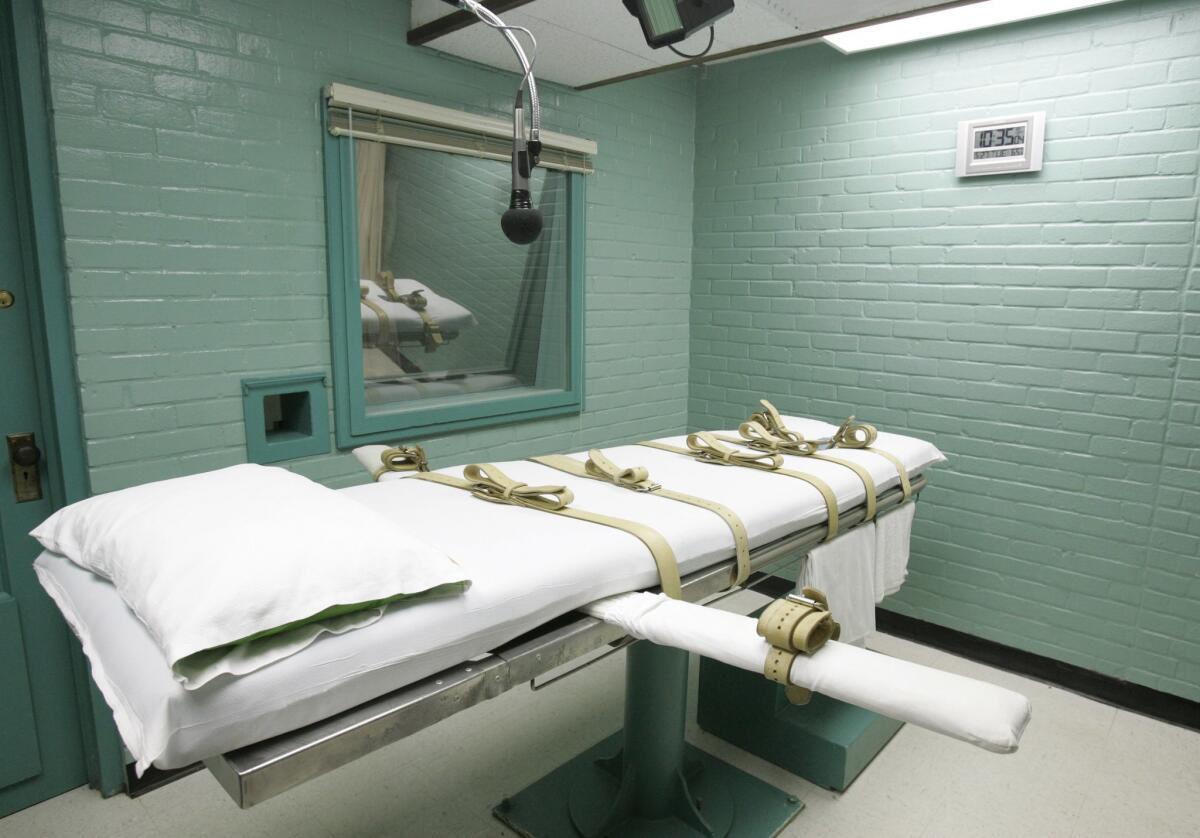Op-Ed: State by state, the death penalty is losing ground

FILE - The gurney in Huntsville, Texas, shot in 2008, where Texas’ condemned are strapped down to receive a lethal dose of drugs.
- Share via
When the Connecticut Legislature abolished the state’s death penalty three years ago, it explicitly left in place the death sentences of those who committed their crimes before the repeal. Abolition for future crimes, said the Legislature, not for past crimes.
But last week, in a landmark 4-3 decision, the Connecticut Supreme Court found that the death penalty violates the state’s constitutional ban on cruel and unusual punishment, and that abolition must therefore extend to everyone. The 11 prisoners on the state’s death row, plus a 12th man facing a death sentence, have been spared.
Although the State of Connecticut vs. Eduardo Santiago ruling definitively bans capital punishment in Connecticut, it raises three key questions about the death penalty nationally.
The first question is for the U.S. Supreme Court: How many states must abolish the death penalty before the high court will strike it down for good? Whenever the high court next turns its attention to the validity of capital punishment, it will look to “objective evidence of contemporary values,” something much discussed in the Santiago case. Nineteen states have abolished the death penalty. Are 19 states — as opposed to, say, 26 — sufficient to tip the constitutional scales toward invalidation nationally?
The Connecticut Supreme Court’s 92-page majority opinion suggests that the answer should be yes. “If the legally salient metaphor is the evolution of our standards of decency,” write the Connecticut justices, “then a gradual but inexorable extinction may be as significant as the sociological equivalent of the meteor that, it is believed, suddenly ended the reign of the dinosaurs.”
In short, abolition does not need a majority; 19 should do. This is especially true given that most states retaining the death penalty are retentionist in name only. “Of the 35 executions carried out in 2014,” the Connecticut Supreme Court tells us, “approximately 90% occurred in just four states: Texas, Missouri, Florida and Oklahoma.” These four states are the proverbial tail wagging the dog of our standards of decency.
The second question is for state legislators throughout the country seeking to abolish the death penalty: What now? In many ways, the Connecticut justices have strengthened these legislators’ arguments by writing far and away the most persuasive testimony in support of repeal.
But the court’s decision has also complicated matters. Here’s why.
Since 2007, seven states have abolished the death penalty. Most have done so for future crimes only, leaving to governors and parole boards the hard question of what to do with prisoners currently on death row. Others are lining up to do the same, including Delaware, Kansas, Washington state, Colorado and New Hampshire.
According to the Connecticut Supreme Court, however, maintaining the death penalty after repeal is unconstitutional. If legislatures are going to repeal the death penalty, they have to do it for everyone, or the court will do it for them.
Nebraska public officials, meanwhile, have argued just the opposite. When Nebraska abolished its death penalty this year, for future and previous crimes, its governor and attorney general cried foul, saying that the Legislature’s repeal of the death penalty for people on death row violated the governor’s power to commute sentences.
Legislators are now in a pickle. According to Connecticut’s high court, it is unconstitutional for a legislature to leave people on death row after repeal; it violates “evolving standards of decency.” Nebraska’s governor and attorney general argue, though, that it would violate the constitutional separation of powers for a legislature not to leave those convicts on death row.
Both can’t be right. The Connecticut ruling has yielded a puzzle that legislatures, governors and courts will be sorting out for some time.
The third question is for all of us: Do we, as a society, approve of vengeance? Supporters of the death penalty say that a legitimate desire for closure and restoration of moral order motivates the death penalty, not vengeance. But that is nonsense. The primary reason that Connecticut’s Legislature retained the death penalty for those on death row in 2012, Connecticut’s justices tell us, was “to placate the public’s desire to exact vengeance” on two particular offenders, “the much reviled perpetrators of the widely publicized 2007 home invasion and murder of three members of Cheshire’s Petit family.”
The court noted in its ruling that one of Connecticut’s state senators suggested they be lynched: “They should bypass the trial [in the Cheshire case] and take that second animal and hang him by his penis from a tree out in the middle of Main Street.”
This is the festival of cruelty that the death penalty incites. Do we approve, or have we evolved?
Kevin M. Barry is a professor of law at Quinnipiac University School of Law and a civil rights attorney, specializing in legislative advocacy and litigation in support of death penalty abolition.
Follow the Opinion section on Twitter @latimesopinion and Facebook
More to Read
A cure for the common opinion
Get thought-provoking perspectives with our weekly newsletter.
You may occasionally receive promotional content from the Los Angeles Times.






